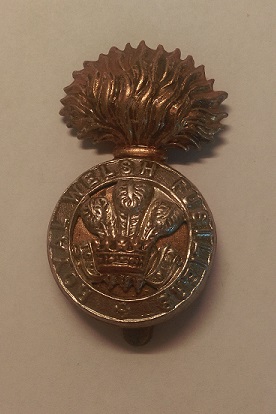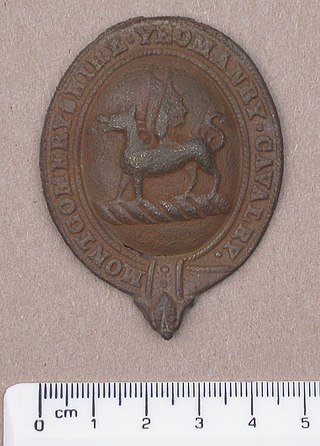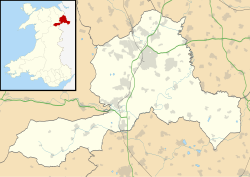
The Royal Welch Fusiliers (Welsh: Ffiwsilwyr Brenhinol Cymreig) was a line infantry regiment of the British Army, and part of the Prince of Wales' Division, that was founded in 1689; shortly after the Glorious Revolution. In 1702, it was designated a fusilier regiment and became the Welch Regiment of Fusiliers; the prefix "Royal" was added in 1713, then confirmed in 1714 when George I named it the Prince of Wales's Own Royal Regiment of Welsh Fusiliers. In 1751, after reforms that standardised the naming and numbering of regiments, it became the 23rd Regiment of Foot (Royal Welsh Fuzileers). In 1881, the final title of the regiment was adopted.

160th (Welsh) Brigade or Brigâd 160 (Cymru), is a regional brigade of the British Army that has been in existence since 1908, and saw service during both the First and the Second World Wars, as part of the 53rd (Welsh) Infantry Division. It is a regional command responsible for all of Wales. The Brigade is also regionally aligned with the Eastern European and Central Asian regions as part of defence engagement.
Options for Change was a restructuring of the British Armed Forces in summer 1990 after the end of the Cold War.

The Royal Welsh is an armoured infantry regiment of the British Army. It was established in 2006 from the Royal Welch Fusiliers and the Royal Regiment of Wales.
The Royal Welsh Regiment was an infantry regiment of the Territorial Army in the United Kingdom. It existed from 1999, until it was re-designated as the 3rd Battalion, The Royal Welsh in 2006.
The Prince of Wales's Division was a British Army command, training and administrative apparatus designated for all land force units in the West of England and Wales. It merged with the Scottish Division, to form the Scottish, Welsh and Irish Division; at the same time the Mercian Regiment joined with the King's Division.

The 11th Security Force Assistance Brigade is a brigade of the British Army which is intended to train and assist foreign forces. In 2021, under the Future Army changes, the brigade was redesignated, formerly being the 11th Infantry Brigade & HQ South East. Prior to the Army 2020 changes in 2013, the brigade was temporarily activated for deployment to Afghanistan, and before that engaged during the two World Wars.
The 1957 White Paper on Defence was a British white paper issued in March 1957 setting forth the perceived future of the British military. It had profound effects on all aspects of the defence industry but probably the most affected was the British aircraft industry. Duncan Sandys, the recently appointed Minister of Defence, produced the paper. The decisions were influenced by two major factors: the finances of the country and the coming of the missile age.
The Denbighshire Hussars was a Welsh Yeomanry regiment of the British Army formed in 1794. It saw service in the First World War before being converted into a unit of the Royal Artillery. The lineage has been continued by 398 Squadron, Royal Logistic Corps.

The Montgomeryshire Yeomanry was a Welsh auxiliary unit of the British Army first formed in 1803. It served in home defence and for internal security, including deployments to deal with Chartist disturbances in the 1830s. It provided volunteers to the Imperial Yeomanry during the Second Boer War and formed three regiments for service during World War I. It was broken up and converted to infantry and artillery in 1920.
The 158th Infantry Brigade was an infantry brigade of the British Army that served in both the First and Second World Wars, before being disbanded in 1968. Throughout its existence the brigade was assigned to the 53rd (Welsh) Infantry Division and was composed almost entirely of Territorial battalions from the Royal Welch Fusiliers.

The regimental depot of a regiment is its home base for recruiting and training. It is also where soldiers and officers awaiting discharge or postings are based and where injured soldiers return to full fitness after discharge from hospital before returning to full duty. Normally, a variety of regimental stores will also be kept at the depot. The regimental depot is not the same as the regimental headquarters, though in practice the two will often be co-located in the same place.
In September 1939, the British Army was in process of expanding their anti-aircraft and mobile assets. Among these new changes was the formation of Anti-Aircraft Command which was formed on 1 April 1939, and the 1st Armoured Division formed in 1937. The list below will include the British Army units, colonial units, and those units which were in the process of formation.

Maindy Barracks is a military installation in the Cathays district of Cardiff in Wales.

The Poyser Street drill hall is a former military installation in Wrexham, Wales.
The 1st Denbighshire Rifle Volunteers, later 4th (Denbighshire) Battalion, Royal Welch Fusiliers, was a Welsh unit of the British Army's auxiliary forces. First raised in 1860, it served as a pioneer battalion with the 47th Division on the Western Front during World War I and with the 53rd (Welsh) Division in North West Europe during World War II. It continued in the postwar Territorial Army through a series of mergers until finally amalgamating with another Welsh battalion in 1999.
The Welsh Volunteers, was a short-lived Territorial Army infantry regiment of the British Army, that existed from 1967 to 1971.
The Denbighshire Militia, later the Royal Denbighshire Rifles was an auxiliary regiment reorganised in the Welsh county of Denbighshire during the 18th Century from earlier precursor units. Primarily intended for home defence, it provided a contingent for service in France in the closing stages of the Napoleonic War. After a series of short-lived mergers with other Welsh militia regiments it became part of the Royal Welsh Fusiliers, It served as a Special Reserve training unit in World War I. After 1921 the militia had only a shadowy existence until its final abolition in 1953.
The Merionethshire Militia, later the Royal Merioneth Rifles, was an auxiliary regiment reorganised from earlier precursor units in the Welsh county of Merionethshire during the 18th Century. Primarily intended for home defence, it served in Britain and Ireland through all Britain's major wars. After a series of shortlived mergers it was finally amalgamated into a militia battalion of the Royal Welch Fusiliers that was disbanded in 1908.










